These dairy free biscuits are made without milk and without butter.
Instead, these biscuits are made with oil and your choice of dairy free milk or water.
Still, they are soft, fluffy, flaky, and crumbly on the inside.
Biscuits are a quintessential part of Southern cuisine like cornbread and fried chicken.
They are usually eaten with butter or jam, or covered in sausage gravy or country gravy.
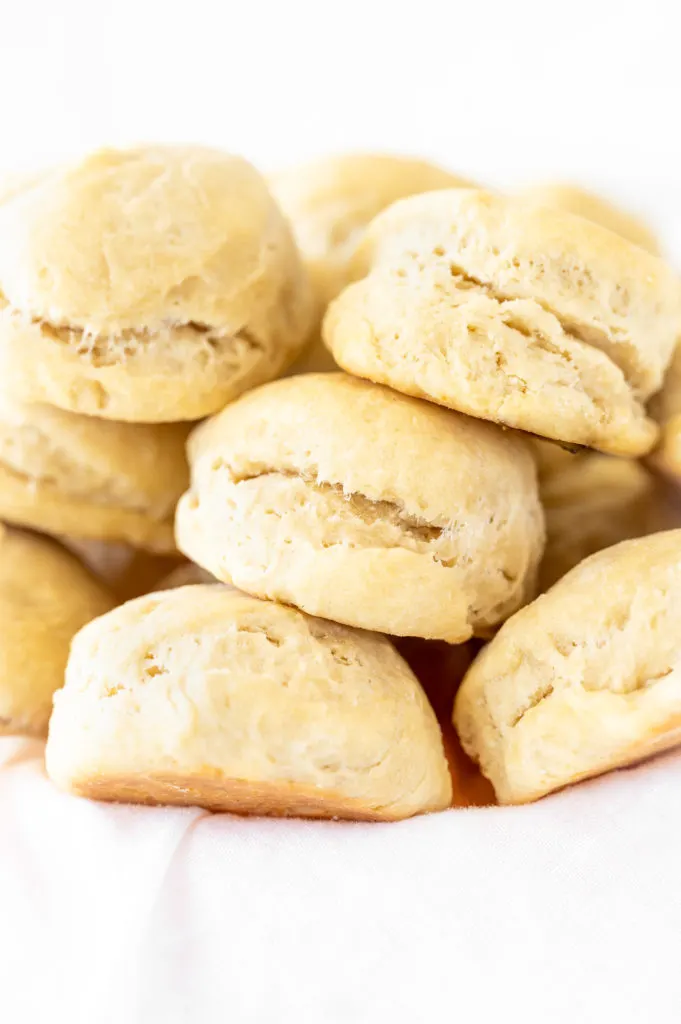
Personally, I enjoy my biscuits warm from the oven and spread with jam or as biscuits and gravy.
I often find meats to be a little much for breakfast and more of a brunch thing, so I think biscuits and gravy without the sausage are really nice too.
Biscuits are also common to find served at family dinners, such as Thanksgiving.
Though, I personally prefer serving southern yeast rolls because they are so light and fluffy.
Since these dairy free biscuits are made without milk or butter, I find them very easy to make at home.
If you like these biscuits without milk, you may also like my buttermilk biscuits without buttermilk.
History of Biscuits
Early European settlers in the United States brought with them a simple, easy style of cooking.
It was usually based on ground wheat and warmed with gravy as a source of cheap nutrition.
This was the foundation for biscuits.
The biscuit emerged as its own food in the early 1800s as a cheap addition to meals. It had the benefit of not requiring yeast.
At this point in time, bread was made only once a week. Also, yeast was a byproduct of making beer, commonly known as emptins.
So, if you lived in a city and close to a brewery, you had relatively easy access to it. However, if you were not so lucky, it was either difficult to attain or you had to try to make some version of it at home.
Even once panned yeast was created by the turn of the century, it was still not easy to acquire.
With due to the lack of yeast, beaten biscuits (or sea biscuits as they are known in New England) were developed. They were similar to hardtack.
These biscuits were beaten and folded to incorporate air into the dough which expanded when heated in the oven, causing the biscuit to rise.
They were beaten for anywhere from 15 minutes to 45 minutes using a rolling pin, hammer, side of an ax, or handle of a musket.
These biscuits were eaten with gravy, and it wasn’t long before biscuits and gravy was created.
Then, with commercial baking powder becoming available in the middle of the century, it made the fluffy biscuit we know today possible.
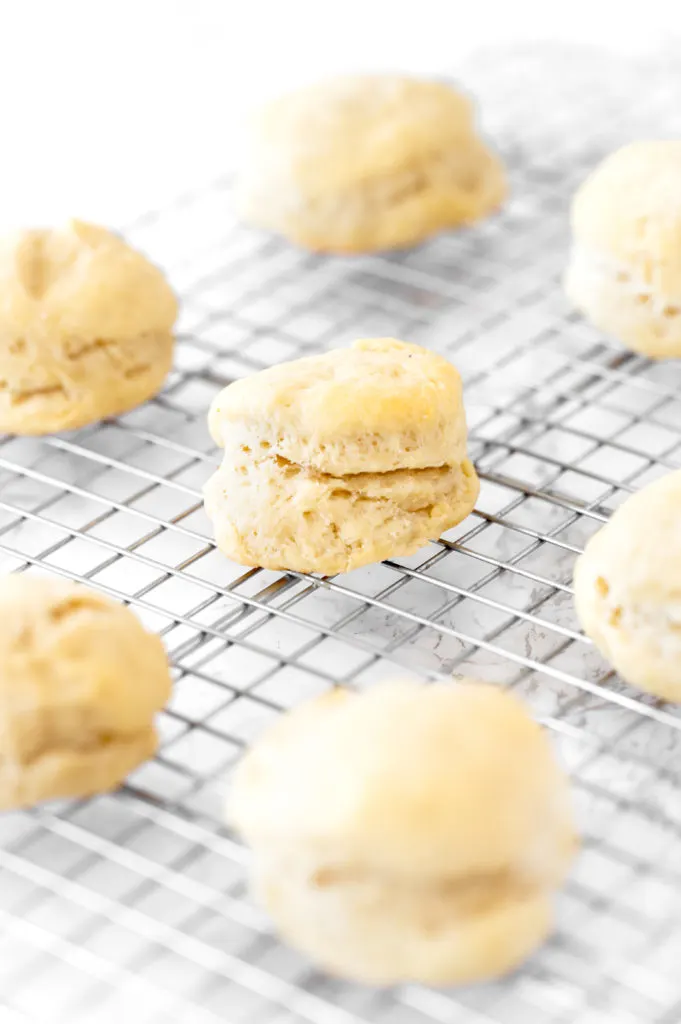
About Dairy Free Biscuits
Biscuits are normally dairy because they are typically made with milk or buttermilk and butter.
However, you can make biscuits without milk by replacing the milk with dairy free milk or you can make the biscuits with water instead of milk.
And you can make biscuits without butter by replacing the butter with vegan butter, kosher margarine, or oil.
To make buttermilk biscuits without buttermilk, replace the buttermilk with a dairy free buttermilk.
Biscuits made with water, unsweetened almond milk, and neutral flavored oat milk all taste like biscuits made with regular milk.
If you want to make biscuits with coconut oil, you can use hardened coconut oil and then make the biscuits like you would with butter.
However, if you want to make biscuits with olive oil, canola oil, and other oils, you can, but the technique is slightly different. Make sure to see the instructions in the recipe.
How Can I make Drop Biscuits without milk?
To make drop biscuits without milk, follow this recipe but increase the oil to ½ cup and the water to ¾ of a cup.
Then, instead of cutting out the dough into biscuits, scoop the batter into mounds (about 3 tablespoons per mound) and place on the baking sheet.
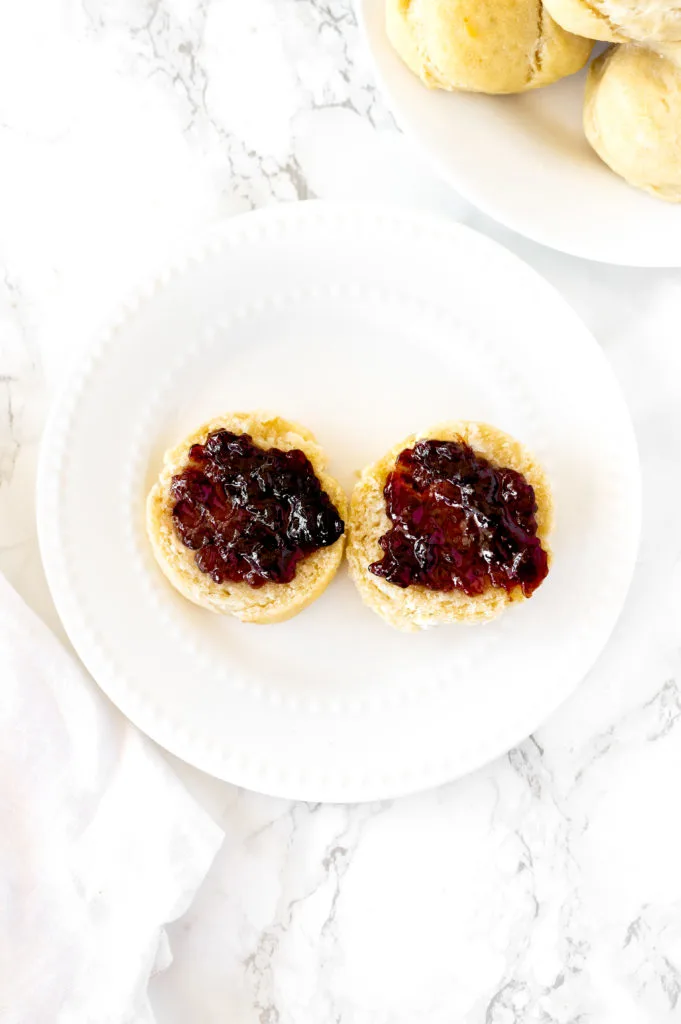
HOW TO MEASURE FLOUR AND OTHER DRY INGREDIENTS
The best way to measure dry ingredients is with a scale. However, this is not commonly done in the United States, where dry measuring cups are used instead.
To measure most dry ingredients, first spoon them into a dry measuring cup and then level off the measuring cup with an upside-down butter knife.
Make sure not to pack it down because it can lead to using more of the ingredient than called for.
The exception is brown sugar. To measure brown sugar, pack it into the measuring cup and then level off any excess.
To measure chocolate chips, nuts, or dried fruit, just pour them in and then level them off.
DRY VS LIQUID MEASURING CUP
Dry measuring cups are a set of cups that often come with measuring spoons. Each cup is a different measurement just like each spoon is a different measurement.
Liquid measuring cups, on the other hand, are cups that have measuring lines on the side to mark the measurements.
The problem with using liquid measuring cups to measure dry ingredients (like flour and cocoa) is that they are powders. So, as you shake the cup to level them off, the powders settle and you end up with more than you need.
I tested this with a friend who didn't believe me and we ended up with a number of tablespoons more than the recipe called for.
WHY sift Powdery Ingredients
There are a number of benefits to sifting powdery ingredients like flour and cocoa.
First of all, flour is often sifted before use to aerate it and remove any lumps. This helps in achieving a lighter texture in baked goods.
Secondly, if you measure flour that's just been sifted, you can get a more accurate measurement than from flour that's been packed tightly in a bag.
In addition, sifting dry ingredients together, such as flour, cocoa, and baking powder, helps make sure they're evenly dispersed.
A Note on Flour
This recipe calls for all-purpose flour, baking powder, and baking soda.
I do this to make the recipe easy for anyone to make.
However, many people use self-rising flour to make biscuits.
If you'd like to, then use 2 cups of self-rising flour instead of the all-purpose flour, baking powder, and ½ a teaspoon of salt.
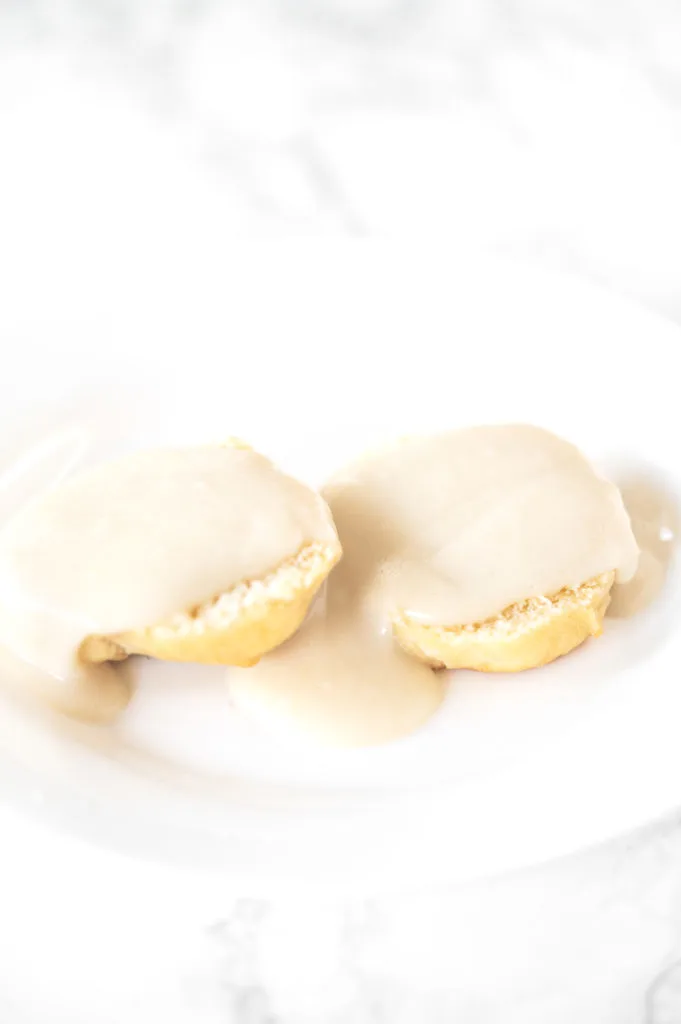
BAKING WITH OIL
Baking with oil produces a moister and tenderer texture compared to that of baked goods made with butter.
Cakes, cupcakes, muffins, and quick breads also tend to bake up taller with a better crumb and stay moist and tender much longer than recipes made with butter.
Also, since oil weighs less than butter, baked goods made with oil have a lighter texture than those made with butter.
In addition, butter is usually only 80% fat, whereas oil is 100% fat. As a result, the water that's present in butter strengthens the gluten in the flour, making it more dense and less tender than baked goods made with oil.
Oil is often used in recipes where a lighter and airier texture is desired or in recipes that call for both oil and butter, in order to have the benefits of oil while keeping the butter flavor.
Which Type Of Oil to Use
I use neutral oils like canola oil, safflower oil, and vegetable oil. You can also use stronger oils like olive oil and coconut oil, but they may change the taste somewhat.
Is it better to use canola oil or olive oil?
Canola oil is relatively cheap and, due to its lack of flavor and high smoke point, is very versatile.
Olive oil, on the other hand, is healthier. Also, its stronger flavor makes it preferable in recipes such as focaccia, which require its distinct taste.
Baking with Oil Conversion Chart
If you want to convert your butter recipes to oil recipes, take a look at my baking with oil - butter to oil conversion chart.
How to store Oil
Store oils in a cool, dark place to prevent them from becoming rancid.
If refrigerated, some oils, like olive oil, may solidify, but will return to a liquid state at room temperature.
Coconut oil begins to solidify in temperatures under 76ºF or 25ºC.
Sugar
The primary role of sugar is to be a sweetener. However, sugar also contributes to the tenderness and moistness of the baked good by absorbing and retaining moisture and helps create the golden brown color when baking as it caramelizes.
Recipes with more sugar often result in softer, moister textures. However, I learned the hard way that too much sugar leads to a sticky mess.
When it's heated, sugar caramelizes, resulting in a rich, complex flavor and a brown color. This adds both flavor and color to baked goods and is also the process in which caramel sauce, dulce de leche, caramel candies, and regular candies are made.
When used in recipes containing yeast, the sugar is eaten by the yeast, producing carbon dioxide and causing the dough to rise.
Sugar also acts as a preservative in jams, jellies, and fruit preserves by reducing water activity and preventing microbial growth.
There are many different types of sugar, including white sugar, brown sugar, vanilla sugar, powdered sugar, turbinado sugar, and demerara sugar.
When a recipe calls for “sugar” without specifying anything else, it's referring to regular white sugar.
White Sugar
White sugar (sometimes called granulated sugar, table sugar, or white granulated sugar) is made of either beet sugar or cane sugar, which has undergone a refining process.
It is the easiest to find and most commonly used.
Brown Sugar
Brown sugar is white sugar with molasses added to it.
It is commonly used in chocolate chip cookie recipes, and it’s rare for a recipe that calls for brown sugar not to also call for white sugar as well.
When a recipe calls for “brown sugar” but doesn’t specify what type (light or dark), it is referring to light brown sugar.
In my recipes, you can use whatever type of brown sugar you have on hand, whether it is dark brown sugar, light brown sugar, or demerara sugar - which is very common in Israel.
Just keep in mind that the flavor and color will be slightly different, depending on what you choose to use.
Turbinado Sugar
Turbinado sugar is better known as "raw sugar." But, despite this name, the sugar is not really “raw.”
Instead, it's partially refined sugar that retains some of the original molasses.
The term "raw sugar" may also give off the impression that it is somehow healthier.
In reality, turbinado sugar is nutritionally similar to white sugar.
Demerara Sugar
Demerara sugar is very popular in Israel and is especially delicious in tea, but is also used for baking.
Unlike white sugar, demerara sugar undergoes minimal processing and retains some vitamins and minerals.
However, it is still not much healthier than white sugar.
Vanilla Sugar
Vanilla sugar is not very common in the States. However, it is common in Israel and parts of Europe.
This is sugar that sat for an extended period of time with vanilla beans, giving it a vanilla flavor.
Caster Sugar
This type of sugar is common in the United Kingdom.
It has a grain finer than white (granulated) sugar and larger than powdered sugar.
Caster sugar is often called for in recipes for delicate baked goods like meringues, souffles, and sponge cakes.
You can use a 1:1 conversion rate between caster sugar and white (granulated) sugar.
Powdered sugar
Powdered sugar, sometimes known as confectioners’ sugar, is a sugar with a powdered texture.
This sugar is rarely used for baking. Instead, it is used for dusting desserts and making frosting, icing, and glazes.
In some countries, you can also find powdered vanilla sugar.
It is made the exact same way regular vanilla sugar is made. However, the sugar used is powdered instead of granulated.
Vanilla Extract vs Vanilla sugar
In my recipes, I don’t specify what kind of vanilla to use.
The reason for this is that in the States, vanilla extract is exclusively used.
Meanwhile in Israel, along with many European countries, vanilla sugar is common.
In most, if not all recipes, both vanilla extract and vanilla sugar can be used.
In recipes where vanilla sugar can be used instead of extract, you can replace them 1:1.
Replacing Sugar with Honey
If you’d prefer to use honey instead of sugar, you can do so with pretty good results.
Honey can be two or even three times as sweet depending on the honey, so for every 1 cup of sugar, you can use ½ to ⅔ cup honey.
Since honey adds liquid, you need to remove some to balance it out. For every cup of honey, remove a ¼ cup of liquid.
Also, it burns faster than granulated sugar, so you want to lower the baking temperature by 25 F. In addition, check it early and often to avoid burning or overbaking.
How to Store Sugar
Sugar should be stored in an airtight container to prevent clumping and moisture absorption, and kept in a cool, dry place.
Which dairy free milk should I use?
Honestly, it's whatever you have on hand or prefer.
My go-to is a neutral flavored full fat oat milk because I find that they are the most similar to regular full fat milk.
Almond milk works well here, too. I personally like using an unsweetened barista almond milk because it is more similar to regular full fat milk, but whatever you have will work.
You can also use coconut milk, though it may have a subtle coconut flavor if you do. Coconut milk has more fat and is similar to using a light cream, but it won't make a noticeable difference.
I've never used soy milk, so I don't have any opinions on it, but you can use that as well.
BAKING SODA VS BAKING POWDER
Both baking soda and baking powder are leavening agents, which means that they help baked goods rise. However, they're not the same thing and they are not interchangeable.
Using baking soda instead of baking powder can give your recipe a terrible metallic taste, while using baking powder instead of baking soda leaves your baked goods looking flat.
BAKING SODA
When baking soda (also known as sodium bicarbonate) is combined with acidic ingredients and exposed to heat, it causes batter or dough rise and contributes to their light and fluffy texture.
However, baking soda is a versatile ingredient. It can be sprinkled over meat to tenderize it and it can be added to tomato sauce to neutralize the acidity.
Baking soda, when combined with an acid - such as cream of tartar, lemon juice, buttermilk, cocoa, and vinegar - creates carbon dioxide. When the carbon dioxide is released, it causes the familiar texture and crumb in pancakes, cakes, quick breads, soda bread, and other baked and fried foods.
A good rule of thumb is to use around ¼ teaspoon of baking soda per 1 cup of flour.
BAKING POWDER
Baking powder is created by combining baking soda, cream of tartar, and sometimes cornstarch.
Since baking powder already contains an acid, it's most often used when a recipe does not call for an additional acidic ingredient or calls for too little of one.
There are two types of baking powder. Single-acting baking powder and double-acting baking power.
Single-acting baking powder gets activated only once - when it gets wet.
Most baking powder sold is double-acting. This means that the leavening occurs in two steps.
The first is when the baking powder gets wet, which is why you cannot prepare some batters ahead of time to bake later. The second step is when the baking powder is exposed to heat, which happens when the batter is baked or fried.
A good rule of thumb is to use around 1 teaspoon of baking powder per 1 cup of flour.
WHY SOME RECIPES CALL FOR BOTH
Some recipes use both baking soda and baking powder because they need extra leavening that the baking soda alone cannot provide.
In these cases, baking soda provides an initial lift, while baking powder provides additional rise.
WHICH ONE IS STRONGER?
You may have already guessed the answer since baking soda is used to make baking powder and you need more baking powder per cup of flour. But I’ll tell you anyway.
Baking soda is four times stronger than baking powder.
That's why you will, more often than not, see recipes that only call for baking soda rather than recipes that only call for baking powder.
HOW LONG DO THEY LAST?
BAKING SODA
Baking soda is good indefinitely past its best by date, although it can lose potency over time.
A good rule of thumb is two years for an unopened package and six months for an opened package.
However, to be honest, I’ve used very old baking soda with good results.
BAKING POWDER
Like baking soda, baking powder is good indefinitely past its best by date, and can lose its potency over time.
For both opened and unopened, it’s ideal to use it within nine months to a year.
While storing it, make sure to keep it in a dry place and away from humidity.
HOW TO TEST IF IT’S STILL GOOD
BAKING POWDER
To test baking powder, pour 3 tablespoons of warm water into a small bowl, add ½ teaspoon of baking powder, and stir.
If the baking powder is good to use, it should fizz a little.
BAKING SODA
To test baking soda, pour 3 tablespoons of white distilled vinegar into a small bowl, add ½ teaspoon of baking soda, and stir.
The mixture should rapidly bubble if the soda is fresh.
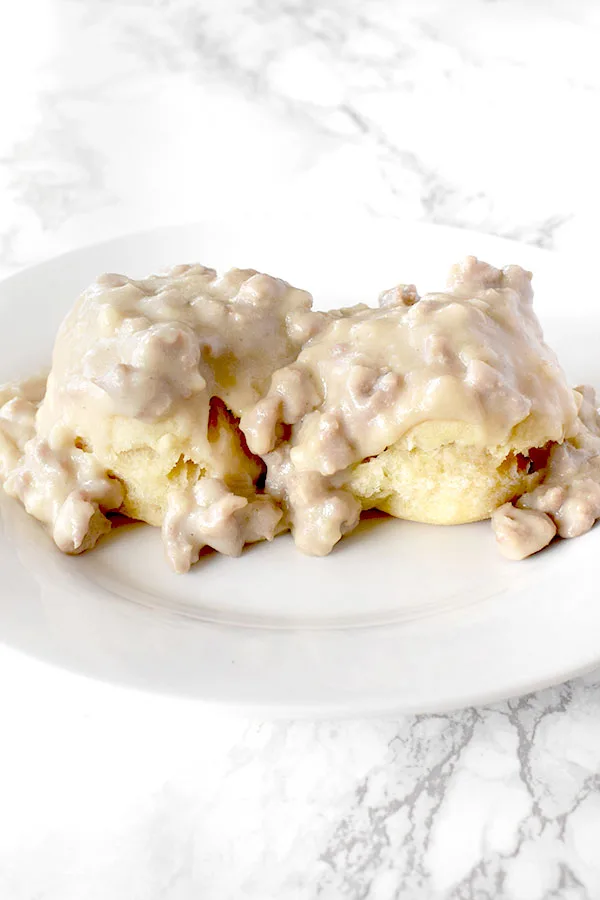
BAKING AT HIGH ALTITUDES
The higher the altitude, the lower the air pressure and the more difficult it is to bake recipes.
Increase by 15 to 25°F or 8 to 14°C. Since leavening and evaporation happen more quickly, the higher temperature helps set the structure of baked goods before they over-expand and dry out.
However, baking at higher temperatures means products are done sooner, so decrease by 5-8 minutes per 30 minutes of baking time.
Adjustment for 3000 feet
- Reduce baking powder: for each teaspoon, decrease ⅛ teaspoon.
- Reduce sugar: for each cup, decrease 0 to 1 tablespoon.
- Increase liquid: for each cup, add 1 to 2 tablespoons.
Adjustment for 5000 feet
- Reduce baking powder: for each teaspoon, decrease ⅛ to ¼ teaspoon.
- Reduce sugar: for each cup, decrease 0 to 2 tablespoons.
- Increase liquid: for each cup, add 2 to 4 tablespoons.
Adjustment for 7000+ feet
- Reduce baking powder: for each teaspoon, decrease ¼ teaspoon.
- Reduce sugar: for each cup, decrease 1 to 3 tablespoons.
- Increase liquid: for each cup, add 3 to 4 tablespoons.
Baking with Humidity
Humidity can have a big impact on how your baked goods come out.
This is because when humidity is extremely high (think 70 percent or more), baking ingredients like flour, sugar, salt, baking powder, and baking soda soak up moisture from the air.
This can negatively impact the outcome of your cakes, cookies, yeast breads, and quick breads.
There are some things you can do to try to save your baking.
Try to counterbalance the additional moisture
To help counterbalance the additional moisture your dry ingredients soak up from the air, try reducing the amount of liquid in the recipe by about one quarter.
If the batter or dough looks too dry once all the ingredients are mixed together, add additional liquid a tablespoon at a time until you have the desired consistency.
This is not usually possible to do for cookies, but it does work for cakes and breads.
Store Ingredients in the Fridge
If flour and sugar are stored in the refrigerator or freezer rather than in a cupboard or pantry, they are better protected from humidity.
As an added benefit, keeping these ingredients cool also helps keep them fresher longer, in addition to helping them stay bug-free.
For the best results, let them warm to room temperature before using.
Bake for Longer
If you bake your goodies for a few extra minutes, it can help the liquid to cook off.
To avoid overbaking, continue testing for doneness every couple of minutes for breads, quick breads, cakes, cupcakes, and muffins. Cookies, on the other hand, need to be checked every minute.
Use Air Conditioning
To help lower humidity levels on humid summer days, air condition the room for at least an hour before you start baking.
Cooler air isn’t able to hold as much moisture as warm air.
Store your baked goods in an airtight container
Humidity can also ruin your fresh-baked goods because when they are left out, they can absorb moisture.
To avoid this, store them in an airtight container or resealable bag.
Adjusting for a Convection Oven
Convection ovens blow the hot air around, producing around 25 to 30 percent more heat.
Since convection ovens produce more heat, you need either lowering the temperature or shortening the cooking time to compensate.
When recipes specify temperatures and cooking times, it’s for conventional ovens, unless specified otherwise.
A simple rule to follow is to lower the temperature by 25ºF or 14ºC when baking cookies and pies, and 50ºF or 28ºC when roasting meat and poultry. Some convection ovens offer separate settings for baking and for roasting.
You can also leave the temperature the same and instead, shorten the cooking time by 25 percent. For example, if your recipe calls for 60 minutes in the oven, check the food after 45 minutes instead.
However, keep in mind, some convection ovens actually make a heat adjustment for you. That is, if you set a convection oven for 350ºF, it might actually set itself to 325ºF to compensate. So, check your manual before making adjustments.
Recipe Tip
I think it's very helpful to make these biscuits on wax paper like I do my dairy free pie crust made with oil. It makes for easier cleanup and doesn't stick as much.
How to store biscuits at room temperature
Allow the biscuits to cool completely on the baking sheet or wire rack. Then, cover individual biscuits with heavy duty aluminum foil or plastic wrap. Store in a cool and dry place.
You can also store them in an airtight container or a resealable plastic bag. However, they may not store as well.
Store for 1 to 2 days.
How to store biscuits in the refrigerator
Allow the biscuits to cool completely on the baking sheet or wire rack. Then, cover individual biscuits with heavy duty aluminum foil or plastic wrap.
Store for up to a week.
Can You Freeze Biscuits?
Yes. Let baked biscuits sit on a wire rack until completely cool. Then, wrap each biscuit tightly in heavy-duty foil or freezer wrap and store in a gallon-sized freezer bag or airtight container.
They can be stored in the freezer for 2-3 months. After that, they are still safe to eat, but the quality begins to degrade.
How to Reheat Frozen Biscuits
To reheat previously-baked biscuits, transfer the frozen biscuits to a parchment-lined baking sheet and bake in a 350°F or 175ºC oven for 15-20 minutes.
To prevent the biscuits from over-browning, lay a sheet of foil over the frozen biscuits.
Can You Freeze Biscuit Dough?
Yes. After cutting out your biscuits, arrange them on a parchment-lined baking sheet. Cover the baking sheet with plastic wrap and then transfer it to your freezer. Once the biscuits are frozen, you can transfer them to a gallon-sized freezer bag or airtight container.
Store the frozen biscuit dough for up to 3 months. After that, they are still safe to eat, but the quality begins to degrade.
How to Bake Frozen Biscuit Dough
Place the frozen biscuits on a parchment-lined baking sheet. Transfer the baking sheet to a preheated 425°F or 220ºC oven and bake for 20-25 minutes.
Dairy Free Biscuits
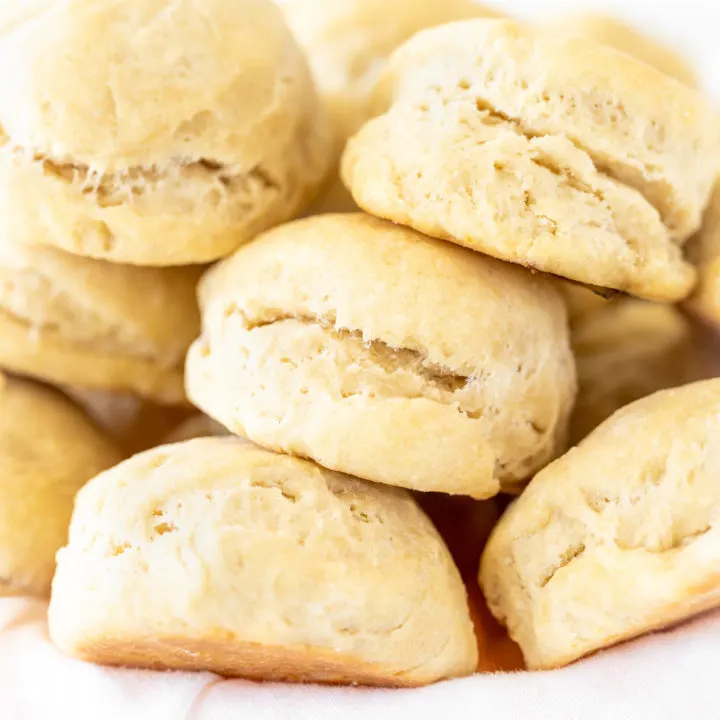
These dairy free biscuits are made without milk and without butter and are soft and fluffy.
Ingredients
- 2 cups flour (250 grams)
- 1 tablespoon sugar, optional
- 1 tablespoon baking powder
- 1 teaspoon salt
- ⅓ cup oil (80 millilitres)
- ⅔ cup water or dairy free milk (175 millilitres)
Instructions
- Whisk flour, sugar (if desired), baking powder, and salt together in a medium size bowl.
- Add oil. Mix with a fork until crumbly.
- Add water or dairy free milk. Mix using a rubber spatula until combined into a very wet dough. If it is too wet to come together into a dough, add more flour a little at a time until it does.
- Preheat oven to 425°F or 218°C.
- Move dough to a well floured surface. Pat the surface with flour.
- Flour your hands well and knead the dough five times by pushing the dough away from you and folding it over itself.
- Use your hands, flatten the dough to ½-inch to 1-inch thick.
- Cut out biscuits as close together as possible using a biscuit cutter or the rim of a cup. 2 to 3 inches wide is ideal.
- Reshape the dough and cut again. Repeat until there is no dough left.
- Place biscuits on a parchment paper lined cookie sheet less than half an inch apart.
- Bake for 12 to 15 minutes or until tops are beginning to lightly golden brown. Remove and serve warm.
Nutrition Information:
Yield:
12Serving Size:
1Amount Per Serving: Calories: 145Total Fat: 7gSaturated Fat: 1gTrans Fat: 0gUnsaturated Fat: 6gCholesterol: 2mgSodium: 310mgCarbohydrates: 18gFiber: 1gSugar: 1gProtein: 3g
Jay
Sunday 23rd of February 2025
I doubled the recipe and it turned out well. I reduced the salt to 1.5 tsp total when I doubled it, but I still found the biscuits a bit too salty. I didn't use the sugar at all, as I was using them to cover a pot-pie. Thanks for the recipe, it was super easy. Thanks!
ElissaBeth
Monday 24th of February 2025
I'm glad you liked it! :)
Kathy Pafford
Saturday 1st of February 2025
Not sure what I did wrong... They are like hard hockey pucks
ElissaBeth
Monday 10th of February 2025
Honestly... I have no idea because that's never happened to me.... Could it be that your oven is running hot? Or that you left them in too long?
Kimberly
Wednesday 16th of August 2023
These biscuits are beautiful! I used warm water and olive oil. I have a 1.5 yr old son who is a very picky eater so I trued making him biscuits. I made him my version before finding this recipe and used my cornbread recipe to adjust to biscuits...I only use olive oil and no eggs in my cornbread but the mad scientist in me added butter as well. BIG FAIL. (My son still gobbled them up!) The butter made them sooo heavy. In google I typed in "Does butter or olive oil make lighter biscuits & your recipe came up. Gave it a try and it was a success. Made 1 inch thick and they are fluffy & tasty! Thanks alot!!!!
ElissaBeth
Tuesday 3rd of October 2023
You're welcome! I'm so glad you liked them :)
Linda
Tuesday 4th of July 2023
These biscuits are so easy to make and delicious. I have doubled the recipe with excellent results too. I originally tried the recipe due to a family member with a dairy allergy, but this has become my go to biscuit recipe. I highly recommend it.
ElissaBeth
Friday 4th of August 2023
Thank you for your comment! :)
Melida
Wednesday 24th of August 2022
If using water, you need to add an acid - like vinegar - to activate the baking powder to help the biscuits rise. I filled my measuring cup with just under 2/3 cup of water and then added vinegar to get to 2/3 cup of liquid. The rise was really nice! i do love the texture the oil gives them! Im making another batch today!
ElissaBeth
Thursday 25th of August 2022
I'm glad you enjoyed the biscuits! Actually, since this recipe calls for baking powder instead of baking soda, the acid is already built in and reacts when the water is added and, since most baking powders are double action, it will react again when exposed to heat. The added acid does give a little extra rise though :) Thanks for sharing!